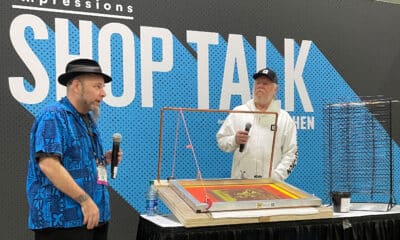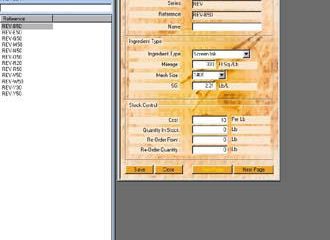Learning Management the Hard Way
Published
19 years agoon
I’ve been involved in screen printing for almost 25 years, most of that time in generally successful supervisory and management positions. Like almost everyone else in this business, I came to the screen-printing industry entirely by accident. I was an out-of-work musician in his early twenties who needed a reasonably paying job with little responsibility and lots of flexibility. I signed on to help a friend who had a small business printing T-shirts.
I’ve been involved in screen printing for almost 25 years, most of that time in generally successful supervisory and management positions. Like almost everyone else in this business, I came to the screen-printing industry entirely by accident. I was an out-of-work musician in his early twenties who needed a reasonably paying job with little responsibility and lots of flexibility. I signed on to help a friend who had a small business printing T-shirts. My job consisted mostly of catching T-shirts off the dryer and cleaning screens, and I figured that I would do it for a while until my big break came along. Well,it never came (surprise, surprise), and here I am 25 years later up to my professional ears in screens, artwork, automatic and manual presses, and the rest of the paraphernalia that comes with this fascinating business. I’ve taken courses throughout my career on almost every aspect of the screen-printing process–screenmaking, four-color-process printing, color matching, team problem-solving techniques, statistical process control, customer service, computerized graphic design, and more. But I was pretty much left to my own devices when it came to the one area in which I probably needed the most help: learning how to actually manage it all. For a long time, I learned my management techniques mostly by accident, through trial and error, and from whatever best-selling book happened to be in vogue at the time. The journey was a long and sometimes hard one, but like most things in this business, it was never boring. Lesson one I worked for the T-shirt guy for a short time and then left for that other haven of the career procrastinator–the record store. I managed that store for a while, until my wife suggested that I should perhaps find a "real" job. Once again, purely by accident, I was hired by a manufacturer of printed circuit boards that was looking for someone with experience in screen printing. I, of course, felt that I fit the bill perfectly with my vast knowledge and months of experience under my belt. (I have since interviewed many applicants who presented similar credentials, and I wonder now how I convinced that company to hire me. I was probably the only person that applied.) I soon discovered that I actually had some talent for screen printing. I also enjoyed the practical side of the job, and this, along with my willingness to work any and all hours of the day and night, put me on the fast track to success. Upper management instantly recognized my genius for organization and immediately promoted me to the position of supervisor. Actually, what really happened was that the previous supervisor threw his squeegee through a pile of screens one morning, announced that he’d had enough, and walked out. I was the employee who turned up that morning, so I became the supervisor. Sounds familiar, doesn’t it? I had no training, but I was in charge and fully intended to make the most of the chance. This is where I learned the "I’m the boss, and you do what I tell you or I’ll fire you" school of management. Who’s the boss? When I became supervisor, I had very little knowledge of the screen-printing process, no management skills, and a ton of work to get out. This was one of the low points in my management career, but you wouldn’t have known it from my yearly performance reviews. I soon gained a reputation as a no-nonsense, in your face, get the job done at any cost, my way or the highway kind of guy. Everyone in my department knew who the leader was and exactly what he expected. The fact that we always had to work overtime and had constant employee turnover didn’t seem to faze anyone, because I was apparently getting the job done. I was also attempting to run the screen shop on nothing more than the force of my personality. I had a career, an ulcer, a mortgage, a child on the way, and a job that I hated. There were no other jobs to be found that paid as well, so I was stuck for the time being. I was lucky though! There was someone in upper management who recognized my inner struggle and suggested that I take some time out and learn some of the technical aspects of screen printing. What a shocking suggestion! It saved my career by putting in place the first building block for successful screen-shop management: Learn the basic principles of screen printing and learn them well. Knowledge leads to enlightenment I am amazed when I run into people who’ve been screen printing for years but still don’t understand the benefits of using a correctly tensioned screen and a sharp squeegee. There is too much "voodoo screen printing" going on out there. Don’t add to the problem; get out there and get an education. Most major industry manufacturers and suppliers, as well as trade associations and events, offer screen-printing courses that are reasonably priced. I don’t care if you never print a four-color-process job–the knowledge and insight that you’ll gain from attending a three-day seminar on process-color printing will forever change your professional life. Remember, there is nothing intuitive about the screen-printing process. Pick the brains of the people who come to sell you things. Make them work for you and for their commissions! Go to shows and find out what’s happening on the cutting edge of our industry. Become a screen-printing enthusiast and start to enjoy what you do. Trust me, I’m the boss As my education continued, I discovered that many of the processes that we routinely followed in the shop were seriously flawed and that a few simple changes could increase our output considerably. I also noted the effect that increased productivity had on my job security. I realized early on that this was, perhaps, the major key to longevity in management. Nobody can argue with the bottom line. If you make the company money, you will be the one who decides when it’s time for a job change, not your boss. I also noticed an interesting phenomenon: As production increased, things ran more smoothly, scrap was reduced, and suddenly we got to spend our evenings and weekends with our families again and not with a bunch of irritable screen printers. It was a huge improvement all around. That was when I began to mellow out and adopted the "Trust me, I’m the boss" approach to screen-shop management. I now understood the basic techniques of screen printing, but my department was still a place where anarchy reigned. From the outside, it looked well ordered–the work was getting done, mostly on time, and I was getting lots of credit for a job well done. However, inside my head was another matter. I desperately tried to keep on top of the ever-changing priorities on the production floor, running from one emergency to the next, pretending that I was in control. I noted the look of suspicion on the faces of my employees when I made decisions, but I reassured them that I understood the bigger picture and that they should trust in me. I then retreated to my office and crossed my fingers and hoped. There was organization, but there was no philosophy behind it. We lived in the moment, and every day was a series of near catastrophes cunningly averted at the last moment. Of course I didn’t live a totally charmed life. Some tragedies were unavoidable. But there were plenty of employees to blame for those mishaps. Many of these employees found other positions elsewhere. Good riddance, I thought. They were very obviously to blame for the scrap, the lack of on-time delivery, and all of the other problems we had. If they weren’t prepared to work within my system, then they should leave. The truth was that there was no system. I still didn’t understand the basic truths of management. But I would inevitably learn that excuses are a very poor foundation on which to build a screen shop. Soon it became my employees’ turn to throw their squeegees through piles of screens and walk out. They didn’t do it all at once, thank goodness, but it became apparent that I couldn’t keep any of my good workers for any length of time. Slowly but surely, I began to realize that the most important person down there on the production floor was not me, but the person pulling the squeegee and pushing the foot pedal. I needed to learn a little humility and rearrange some of my production priorities. I would soon receive some unexpected help. The company I worked for decided that they needed to set up a distribution warehouse and hired a process engineer to help them do it. In all my years of screen printing, this was the first person I had ever met who actually had some formal education in managing production facilities. Over a few beers after work one night, he explained to me the thought processes that he brought to bear on the various production tasks that he was asked to organize. They were so simple–yet so brilliant–that it seemed almost like a religious conversion to me. Much of what I had learned through the school of hard knocks would have to be thrown out like the squeegee through the pile of screens. I set about implementing a shop-management philosophy based on the models that he showed me, and I finally began to be truly successful. What I learned The process engineer reminded me that, as a manager, I was not actually physically producing anything. This made me one of the least important people in the department. He said that I should think of myself as the servant of the process and, to some degree, the servant of the employees who work for me. I learned that the decision to hire or fire should be based on whether the process or the worker is to blame. More often than not, I found that the process was failing the employee and that the employee often had the solution at hand. All I had to do was listen. I started to understand that I didn’t have idiots working for me; I had under-trained people who lacked the basic knowledge to do the job. Training is the key to eradicating a lot of the frustration that a lot of people employed in this industry suffer from. I know it sounds obvious, but some of these points need to be stated and repeated. In my next installment, we’ll take a closer look at some of the basic truths I’ve learned about screen-shop management and examine some practical ways to implement them. About the author Gordon Roberts has a history in screen-printing production management that spans more than 25 years. He has held supervisory positions in shops that represent a broad spectrum of application areas and markets, including printed electronics, apparel, signage, and retail graphics. Roberts has presented training courses on the basics of screen-printing production and on shop management for the Screentech Institute and is presently a consultant for the screen industry.
SPONSORED VIDEO
Let’s Talk About It
Creating a More Diverse and Inclusive Screen Printing Industry
LET’S TALK About It: Part 3 discusses how four screen printers have employed people with disabilities, why you should consider doing the same, the resources that are available, and more. Watch the live webinar, held August 16, moderated by Adrienne Palmer, editor-in-chief, Screen Printing magazine, with panelists Ali Banholzer, Amber Massey, Ryan Moor, and Jed Seifert. The multi-part series is hosted exclusively by ROQ.US and U.N.I.T.E Together. Let’s Talk About It: Part 1 focused on Black, female screen printers and can be watched here; Part 2 focused on the LGBTQ+ community and can be watched here.
You may like
Advertisement

Looking Back at the Early Years of Screen Printing: A Color Separation Showdown

Gildan Donates Surgical Equipment to Mario Catarino Rivas Hospital

INX University Expands Online Curriculum Program
Advertisement
Subscribe

Bulletins
Get the most important news and business ideas from Screen Printing magazine's news bulletin.
Advertisement
Most Popular
-

 Columns1 month ago
Columns1 month ago8 Marketing Mistakes Not to Make When Promoting Your Screen Printing Services Online
-

 Press Releases1 month ago
Press Releases1 month agoSports Inspired Clothing Market: The Influence of Sports on Fashion Forward Looks
-

 Editor's Note1 month ago
Editor's Note1 month agoLivin’ the High Life
-

 Marshall Atkinson1 month ago
Marshall Atkinson1 month agoHow to Create a Winning Culture in Your Screen-Printing Business
-

 Press Releases4 weeks ago
Press Releases4 weeks agoHope Harbor to Receive Donation from BlueCotton’s 2024 Mary Ruth King Award Recipient
-

 Case Studies1 month ago
Case Studies1 month agoScreen Printing for Texture and Depth
-

 News & Trends2 months ago
News & Trends2 months agoWhat Are ZALPHAS and How Can You Serve Them in Your Print Business?
-

 Headlines1 month ago
Headlines1 month agoLive Poster Printing Raises $30K for Charity














